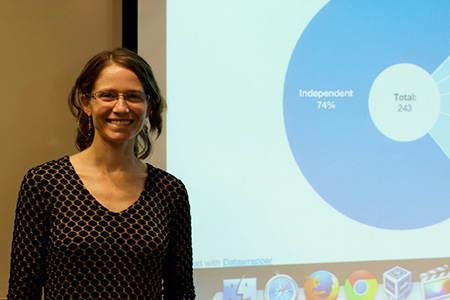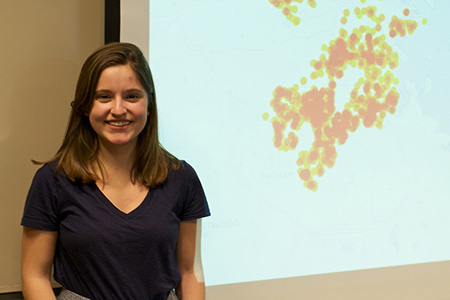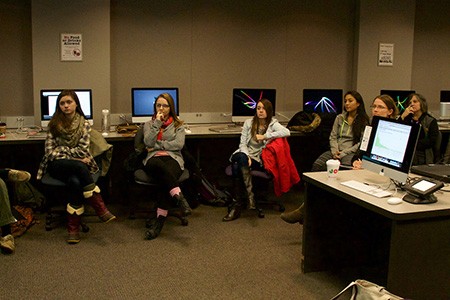Journalism offers data visualization class

Assistant Professor Catherine D'Ignazio is teaching the Journalism Department's new course on data visualization. (Photo by Nick Eaton '17)
Most people would associate a journalism class with article writing or video editing. However, Emerson’s Journalism Department offers a new class focused on something completely different.
Students in Assistant Professor Catherine D’Ignazio’s data visualization course are learning how to go beyond reading Excel spreadsheets to use data to tell stories. The approach gives students a new perspective, thus preparing them for new responsibilities as journalists.
“This is a fairly new idea where journalists, rather than reporting on data from a database or government documents, actually become the data collectors themselves,” said Abigail Collins ’15, one of D’ Ignazio’s students.

Abigail Collins '16 is a student in Journalism's data visualization course. (Photo by Nick Eaton '17)
Class members recently had a hands-on experience when they worked with PublicLab’s Don Blair to create their own sensors to test the conductivity of water samples they collected themselves. Collins said the results alone were not enough to write a story, but it showed students that experiments are important ways of documenting data that will later be used in a story.
D’Ignazio believes the course is beneficial to students because the importance of data in journalism is on the rise. People now have more access to data, and D’Ignazio says it is becoming a more highly valued information format.
“For journalists, data is an amazing untapped resource because you can go into these spreadsheets and take so many clues away from it,” she said. “It can really help you look down the path of a story.”

Journalism students in the data visualization course. (Photo by Nick Eaton '17)
Stories that use data are not always scientific, either. Some of D’Ignazio’s students discovered data in the form of graffiti reports and parking violation records in some of Boston’s neighborhoods. They were able to deduce issues and popular occurrences in these areas just by looking at the data, thus seeing the makings of a story.
D’Ignazio has high hopes for the future of the class and envisions partnerships with groups in the Emerson and Boston community that have a need for data visualization. She says external partners will help shape the arc of larger projects that students will participate in over the course of a semester.
Categories